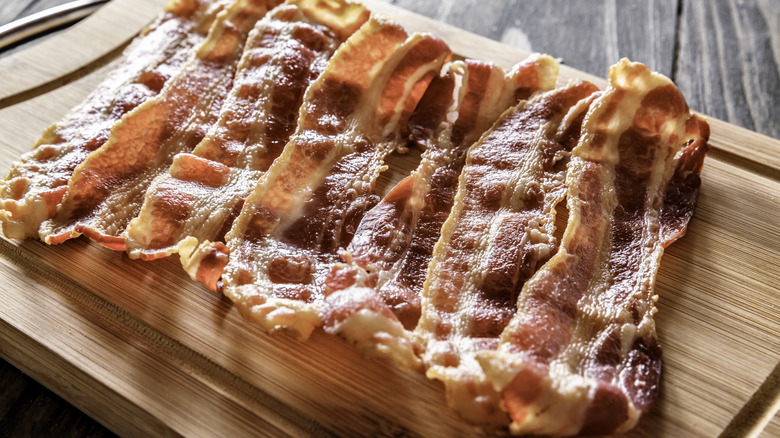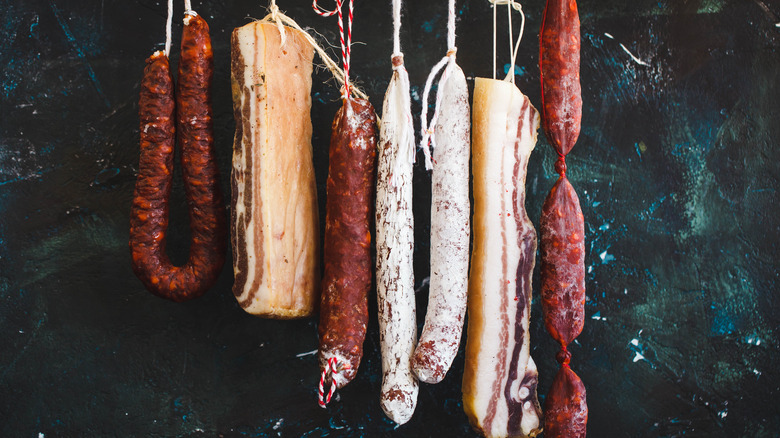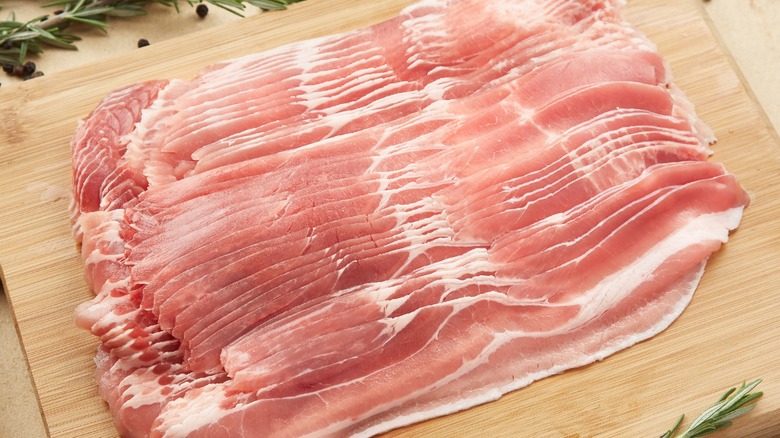The Deceptive Effect Behind 'Uncured' Bacon Labels
Bacon comes from the fatty sections of a pig, typically the belly or back. In America, most bacon features streaks of fat and is sourced from the pork belly, while the leaner, meatier variety from the back is often referred to as Canadian bacon (which doesn't always come from Canada). Most bacon is smoked, and it is always cured, which raises the question: What's the deal with "uncured" bacon labels?
Despite being labeled uncured, such bacon is, in fact, cured. This labeling distinction hinges on the curing agents used — whether they are artificially or naturally sourced nitrites and nitrates. The USDA clarifies that uncured bacon signifies that there are "no nitrates or nitrites added except for those naturally occurring in ingredients such as celery juice powder, parsley, cherry powder, beet powder, spinach, sea salt[,] etc."
Cured bacon, on the other hand, may undergo various curing methods, such as being infused with a curing solution, dry-cured, or wet-cured. These processes typically involve a combination of salt, sugar, and some form of nitrites or nitrates, along with other natural and artificial flavorings. It's important to note that often, even bacon explicitly labeled as free of nitrates or nitrites contains these compounds. This is because different forms of nitrates and nitrites, such as sodium — or potassium — nitrate and nitrite play a crucial role in preventing the spoilage of processed meats.
What is the deal with nitrites and nitrates?
Nitrites and nitrates in isolation aren't harmful. However, nitrates can transform into nitrites. When these nitrites come into contact with amines — compounds found in proteins — during digestion or cooking, they convert into nitrosamines (which, according to Healthline, are potentially carcinogenic). Nitrosamines are present in processed meats, cured fish, beer, other alcoholic beverages, and even in some vegetables like turnips, bok choy, radishes, onions, garlic, and leafy greens.
However, there's no need to discard all your fresh produce. These vegetables are low in protein and amines but high in vitamin C and polyphenols, which, as Medical News Today points out, help inhibit the development of harmful nitrosamines. The real concern arises with the high concentrations of nitrates or nitrites used in meat preservation, whether from synthetic sources as in traditional cured bacon, or natural sources like those in uncured bacon. At the end of the day, they're both preserved.
Of course, dietary choices are highly individual. Some scientists consider foods with nitrates and nitrites hazardous, while others view moderate consumption as acceptable. It's crucial for individuals to understand the risks associated with consuming certain foods and make informed decisions based on their personal health and dietary preferences.
What do other common bacon labels mean?
Slab bacon refers to whole, uncut, cured pork belly. Thick-cut bacon, typically around twice as thick as regular slices, measures approximately ⅛ of an inch. Center-cut bacon is leaner. The term "natural" on bacon packaging is somewhat nebulous and doesn't convey much specific information, but "certified organic" bacon must adhere to stringent guidelines regarding animal treatment and meat processing.
Many commercially produced bacons undergo an accelerated curing process, involving the injection of brine. Conversely, the "dry-cured" or "dry-rubbed" bacon process is lengthier, and many believe it results in superior taste and texture compared to other curing methods.
Sugar plays a crucial role in bacon, balancing flavors and acting as a preservative. Most dry or wet brines contain sugar, unless the label explicitly states no sugar is added. Therefore, a "sugar-cured" label on bacon is quite standard. Salt is also essential for bacon production. Even bacon labeled as low-sodium will contain significant salt compared to uncured meats.
Regarding bacon's characteristic smokiness, labels specifying the type of wood used or terms like "naturally-smoked" or "hardwood-smoked" indicate traditional smoking methods. In contrast, the absence of such labeling often implies the use of liquid smoke to simulate the flavor of actual smoking.



